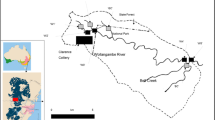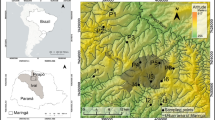Abstract
For the first time, the results of studying the hydrochemical characteristics of bays in the Bratsk Reservoir, subject to the effect of forest harvesting operations are given. The obtained data include the concentrations of NO3−, NO2−, NH4+, PO4-3, SiO2, phenols, oil products, and organic matter and the oxygen regime of water in the bays. The concentration and distribution in water of biogenic elements and O2-typical of wood decay processes-demonstrate the high self-purification capacity of ecosystems in the majority of bays. At the same time, water of some bays shows signs of eutrophication and high concentrations of phenols and oil products.
Similar content being viewed by others
References
Abdrakhmanov, R.F., Shkundina, F.B., and Poleva, A.O., Hydrochemical and hydrobioloigical regime of the Pavlovskoe Reservoir, Water Resour., 2014, vol. 41, no. 1, pp. 87–96.
Bratskoe vodokhranilishche (Bratsk Reservoir), Moscow: Akad. Nauk. SSSR, 1963.
Verbolova, N.V., Formation of the Hydrochemical Regime of the Bratsk Reservoir, in Formirovanie planktona i gidrokhimiya Bratskogo vodokhranilishcha (Plankton Formation and Hydrochemistry of the Bratsk Reservoir), Novosibirsk: Nauka, 1973, pp. 78–119.
Vorob’eva, S.S., Fitoplankton vodoemov Angary (Phytoplankton of Angara Water Bodies), Novosibirsk: Nauka, 1995.
Votintsev, K.K., Gidrokhimiya ozera Baikal (Lake Baikal Hydrochemistry), Moscow: Akad. Nauk SSSR, 1961.
Gorshkov, A.G., Marinaite, I.I., Zemskaya, T.I., and Khodzher, T.V., Present-Day Level of Oil Products in the Water of Lake Baikal and Its Tributaries, Khim. Interesakh Ustoich. Razvit., 2010, no. 18, pp. 711–718.
Drachev, S.M., Bor’ba s zagryazneniem rek, ozer, vodokhranilishch promyshlennymi i bytovymi stokami (Control of Pollution of Rivers, Lakes, and Reservoirs by Industrial and Municipal Wastes), Moscow: Nauka, 1964.
Zenin, A.A. and Belousova, N.V., Gidrokhimicheskii slovar’ (Hydrochemical Dictionary), Leningrad: Gidrometeoizdat, 1988.
Ivanov, I.N., Gidroenergetika Angary i prirodnaya sreda (Angara Hydropower Engineering and the Environment), Novosibirsk: Nauka, 1991.
Karnaukhova, G.A., Hydrochemistry of the Angara and reservoirs of the Angara Cascade, Water Resour., 2008, vol. 35, no. 1, pp. 71–79.
Karnaukhova, G.A., Sedimentation processes in reservoirs of the Angara System, Extended Abstract of Doctoral (Geogr.) Dissertation, Irkutsk: Inst. Earth Crust, Sib. Branch, Russian Academy of Sciences, 2009.
Karnaukhova, G.A., Phosphorus load and eutrophication of the Bratsk Reservoir, Inzh. Ekol., 1998, no. 6, pp. 25–32.
Kozhova, O.M., Vegetation products of the Bratsk Reservoir, in Biologicheskie produkty vodoemov Sibiri (Biological Products of Siberian Water Bodies), Moscow: Nauka, 1969, pp. 71–79.
Kozhova, O.M. and Mel’nik, N.G., Instruktsiya po obrabotke prob planktona schetnym metodom (Guide on Processing Plankton Samples by Counting Method), Irkutsk: Izd. Irk. Gos. Univ., 1978.
Kontrol’ khimicheskikh i biologicheskikh parametrov okruzhayushchei sredy (Monitoring the Chemical and Biological Environmental Characteristics), Isaev, L.K., Ed., St. Petersburg: Ekol.-analit. inform. tsentr “Soyuz,” 1998.
Korobushkina, E.D., Dissolved organic matter in Bratsk Reservoir water, in Tez. dokl. vsesoyuz. nauch. konf. “Problemy ekologii” (Proc. All-Union Sci. Conf. “Problems of Ecology”), Irkutsk, 1982, issue 2, p. 39.
Korpachev, V.P., Perezhilin, A.I., Andriyas, A.A., and Ryabokon’, Yu.I., Zagryaznenie i zasorenie vodokhranilishch GES drevesno-kustarnikovoi rastitel’nost’yu, organicheskimi veshchestvami i vliyanie ikh na kachestvo vody (Pollution and Clogging of HPP Reservoirs by Wood and Bruch Vegetation and Organic Matter and Their Effect on Water Quality), Moscow: Akadem. Estestvozn., 2010.
Makarova, I.V. and Pichkily, L.O., Some issues regarding the procedure of phytoplankton biomass calculation, Bot. Zh. SSSR, 1970, vol. 55, no. 10, pp. 1488–1494.
Nikolaeva, M.D., Bochkarev, P.F., and Miromanov, V.F., Biochemical oxygen demand in Angara R. water (BOD5), Tr. Irk. Gos. Univ., 1970, vol. 50, no. 3, pp. 26–32.
Poleva, A.O., Integrated estimate of Pavlovskoe Reservoir ecosystem (Republic of Bashkortostan), Extended Abstract of Cand. Sci. (Biol.) Dissertation, Ufa: Bash. Gos. Univ., 2009.
Poletaeva, V.I. and Pastukhov, M.V., Assessing Bratsk Reservoir bays by microbiological and hydrochemical characteristics, Voda: Khim. Ekol., 2015, no. 6, pp. 86–91.
Rukovodstvo po khimicheskomu analizu poverkhnostnykh vod sushi (Guide on Chemical Analysis of Surface Continental Water), Semenov, A.D., Ed., Leningrad: Gidrometeoizdat, 1977.
Sakevich, A.I. and Usenko, O.M., Phenol compounds in water of Dnieper reservoirs, Gidrobiol. Zh., 2002, vol. 38, no. 4, pp. 103–112.
Strizheva, T.A., Assessing the trophic type of Angara reservoirs by oxygen hysteresis method, in Krugovorot veshchestva i energii v vodoemakh (Matter and Energy Turnover in Reservoirs), Novosibirsk: Nauka, 1985, no. VII, pp. 74–75.
Sursyakova, V.V., Bondareva, L.G., Burmakina, G.V., and Rubailo, A.I., New approaches to the identification of the sources of phenol inflow into surface water bodies, Dokl. Akad. Nauk, 2011, vol. 441, no. 6, pp. 767–770.
Fengel, D. and Vegener, G., Drevesina. Khimiya, ul’trastruktura, reaktsii (Wood: Chemistry, Ultrastructure, and Reactions), Moscow: Lesnaya prom., 1988.
Fomintsev, M.N., Kuleshova, T.V., and Borodin, Yu.V., Lesosplav i ekologiya: obzor. inform. (Timber Floating and Ecology: Information Review), Moscow: VNIPIEIlesprom, 1989.
Sheveleva, N.G., Popovskaya, G.I., and Pastukhov, M.V., Alieva (Poletaeva) V.I. Assessing the current state of zooplankton in Bratsk Reservoir bays, Byull. MOIP. Otd. Biol., 2012, vol. 117, no. 4, pp. 37–47.
Henderson-Sellers, B. and Marklend, Kh.R., Decaying Lakes: The Origins and Control of Cultural Eutrophication, Wiley: 1987.
Arimoro, F.O., Ikomi, R.B., and Osalor, E.C., The impact of sawmill wood wastes on the water quality and fish communities of Benin River, Niger Delta area, Nigeria, World J. Zool., 2006, no. 2, pp. 94–102.
Edokpayi, C.A., Uwadiae, R.E., and Njar, C.E., Noninsect benthic phytomacrofauna and organism–water quality relations in a tropical coastal ecosystem: impact of land based pollutants, J. Am. Sci., 2010, no. 7, pp. 213–222.
Howarth, R., Anderson, D., Cloern, J., Elfring, C., Hopkinson, C., Lapointe, B., Malone, T., Marcus, N., McGlathery, K., Sharpley, A., and Walker, D., Nutrient pollution of coastal rivers, bays, and seas, Iss. Ecol., 2000, no. 7, pp. 1–15.
Nwankwo, D.I., The influence of sawmill wood wastes on diatom population at Okobaba, Lagos Nigeria, Nigeri J. Botany, 1998, vol. 11, pp. 15–24.
Nwankwo, D.I., Abosede, A.O., and Abdulrazaq, Y., Floating timber logs as a substrate for periphyton algae in the Lagos Lagoon, Nigeria, Polskie Archiwum Hydrobiologii, 1994, vol. 41, no. 4, pp. 419–430.
Smith, V.H., Eutrophication of freshwater and marine ecosystems: a global problem, Environ. Sci. Poll. and Poll. Res., 2003, vol. 10, no. 2, pp. 126–139.
Smith, V.H., Joye, S.B., and Howarth, R.W., Eutrophication of freshwater and marine ecosystems, Limnol. Oceanogr., 2006, vol. 51, pp. 351–355.
Smith, V.H. and Schindler, D.W., Eutrophication science: where do we go from here?, Trends in Ecol. Evolution, 2009, vol. 24, no. 4, pp. 201–207.
Wetzel, R.G., Limnology, Philadelphia: Saunders College Publishing, 1975.
Author information
Authors and Affiliations
Corresponding author
Additional information
Original Russian Text © V.I. Poletaeva, M.V. Pastukhov, N.A. Zagorulko, G.A. Belogolova, 2018, published in Vodnye Resursy, 2018, Vol. 45, No. 3.
Rights and permissions
About this article
Cite this article
Poletaeva, V.I., Pastukhov, M.V., Zagorulko, N.A. et al. Changes in Water Hydrochemistry in Bays of the Bratsk Reservoir Caused by Forest Harvesting Operations. Water Resour 45, 369–378 (2018). https://doi.org/10.1134/S0097807818030119
Received:
Accepted:
Published:
Issue Date:
DOI: https://doi.org/10.1134/S0097807818030119




